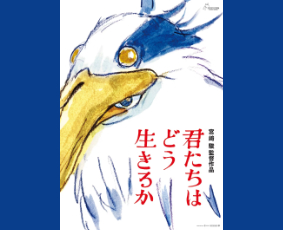君たちはどう生きるか [How Do Y’all Live?] aka The Boy and the Heron, Japan 2023. Directed and written by Miyazaki Hayao.
Bambi Theater 1, Row 2, Seat 7+8. Original version w/ subs.
(This post also appears, slightly abbreviated and in two parts, at my Instagram account betweendrafts.)
To start with, “The Boy and the Heron” deserves the Golden Dingleberry in the category “Worst Localized Movie Title of the Year,” if there is such a thing. It’s not a buddy movie, for goodness’ sake, and there are many side characters who are more important and more interesting than the Heron. It’s as if Disney had called its 1998 animated movie not Mulan but “The Girl and the Dragon,” and even that would have been less misleading. Or the first Star Wars from 1977 had been called “The Boy and the Jedi.” You get the drift.
Which, however, doesn’t mean that the original title makes more sense. How Do Y’all Live? is the title of a novel written by Yoshino Genzaburō, published in 1937. The book makes an appearance in the movie but has a completely different story, and Yoshino’s grandson himself—even after visiting Miyazaki together with his father—expressed bewilderment over this choice.
Now, the movie itself.
How Do Y’all Live? is a stunning artistic and technical achievement and an abysmal failure as a movie. For a Studio Ghibli work written and directed by Miyazaki himself, it was a profoundly unexpected blow that was also a slow-burner: the movie starts out spectacularly good, and I gave it the benefit of the doubt way too long after it fell apart.
The 2006 animated movie ゲド戦記 [Ged’s War Diary] aka Tales from Earthsea, directed by Miyazaki Hayao’s son Miyazaki Gorō, might provide some lessons. It was so shockingly bad that, besides walking out of the premiere, Miyazaki Hayao remarked that “you shouldn’t make a film based on your emotions.” I feel that this is exactly what happened to How Do Y’all Live?, as a movie based on his own childhood memories. Another Earthsea remark was, “I was looking at my kid—he’s not an adult yet.” That came around to bite him too. How Do Y’all Live?, instead of capturing a profound childhood experience, is an all-you-can-eat children’s buffet at best.
In stark contrast to the tightly woven spirit world of 千と千尋の神隠し [Sen to Chihiro no Kamikakushi] aka Spirited Away, How Do Y’all Live?’s fantasy world has no discernible rules, protocols, and etiquettes. And in equally stark contrast to it, there’s no dramatic arc, no recognizable character development, no raising the stakes, no emotional pull, no side character motivations, no insights into outer and inner worlds. Every world rule is pulled out of a hat like an overworked rabbit, often with deus-ex-machina properties—be it an accidental feather with a string of disparate but blazingly useful magical properties, or be it a magic room which, without warning or explanation à la old-fashioned D&D traps, has life-threatening ramifications if entered.
It’s a pity. The movie has a long, beautiful, spell-binding introductory act, but after the protagonist discovers his granduncle’s magic tower, which will turn out to be some kind of spaceship and an access hub to alternative worlds, the script deteriorates into an interminable string of action scenes and dazzling effects that are so haphazardly glued together as to feel procedurally plotted. (They’re all pretty, though, and technically accomplished, with the notable exception of a turd-like flying rock.) In the ensuing screaming cluttery mess, backdrops and characters and threats and mysteries come and go with dizzying speed and ever accumulating portents that never resolve nor have significant repercussions. Until, finally, everything aggregates into a bizarre hodgepodge of “elderly Einstein-ish unkempt wizard-figure keeps worlds in balance by stacking 13 toy blocks on top of each other on a garden table while being challenged by a giant bird in regalia who is the emperor of an army of man-eating parakeets who was introduced as an adversary two scenes ago.”
Yes, it’s that bad.
Also, while I’m all for intertextuality, it’s conspicuously overcooked. Spotting the obvious classics feels a lot like birdwatching, only that they’re too easy to spot and considerably less clever and delightful than expected. The Disney motifs—particularly Snow White complete with coffin and seven dwarfish personalities—are delivered as subtly as left hooks on the nose. The Warawara spirits are wholesale Kodama rip-offs from Miyazaki’s own もののけ姫 [Mononoke Hime], only bubbly. Also, to call copying de Niro’s iconic final scene from Brazil an homage would be a stretch.
Reviews fawn about the movie with “biographical similarities,” messages of “creating a world without conflict with your own hands,” “exploring themes of coming of age,” “coping with a world marked by conflict and loss,” “learning to accept change,” and other yawning descriptors. Topics which, at most, the movie “explores” but never comes close to deliver. But hey—it also “deliberately includes scenes of bird droppings, which provides comic relief.” Yes, that’s from an actual review.
I can only guess, but the movie’s seven years of development are more than enough for a script to sprawl out and lose focus, the more so if it’s biographically inspired. Even Hisaishi’s score falls flat over it, sadly.
Maybe there was a rule system under the hood once. Maybe, deep down, everything was anchored once. But the rules and the anchor were lost on the way, and with it any message the movie might have been meant to deliver.
________________
All Movie Reviews
If you have something valuable to add or some interesting point to discuss, I’ll be looking forward to meeting you at Mastodon!

